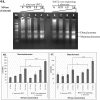HAT2 mediates histone H4K4 acetylation and affects micrococcal nuclease sensitivity of chromatin in Leishmania donovani
- PMID: 28486547
- PMCID: PMC5423686
- DOI: 10.1371/journal.pone.0177372
HAT2 mediates histone H4K4 acetylation and affects micrococcal nuclease sensitivity of chromatin in Leishmania donovani
Abstract
Histone post-translational modifications (PTMs) such as acetylation and methylation are known to affect chromatin higher order structures. Primary targets of these modifications include basic residues present at N-terminus tail region of core histones. Four histone acetyltransferase (HAT) genes have been identified in trypanosomatids. HAT1, HAT3 and HAT4 of Leishmania donovani have been partially characterized. However, there is no report about HAT2 of Leishmania donovani. Lysine residues present on the N-terminal tail of Leishmania donovani histone H4 are conserved in other trypanosomatids and humans. PTMs of lysines modulate various functions at chromatin level. The four histone acetyltransferases encoded in Leishmania genome were over-expressed to analyse their functional activity. All four HATs were found actively acetylating core histones H3/H4. Similar to L. donovani HAT3 and HAT4, HAT2 was found to be a member of MYST family protein and have SAS2 type domain. Over-expression of HAT2 significantly increases acetylation of H4K4. To analyse the effect of HAT2 over-expression on chromatin accessibility, micrococcal nuclease digestion assay was performed. MNase digestion resulted in a higher proportion of the mononucleosomes and dinucleosomes in HAT2 over-expressing cells as compared to WT L. donovani cells. Acetylation of lysine-4 neutralizes the amino terminal region of histone H4. This weakens its interaction with neighbouring nucleosomes and the linker DNA. HAT2 over-expression in L. donovani resulted in highly accessible chromatin suggesting chromatin decondensation. HAT2 may have an important role to play in global regulation of transcription in L. donovani. Better understanding of these epigenetic determinants of parasite would help in designing novel therapeutic strategies.
Conflict of interest statement
Figures




Similar articles
-
Histone H4 lysine 14 acetylation in Leishmania donovani is mediated by the MYST-family protein HAT4.Microbiology (Reading). 2012 Feb;158(Pt 2):328-337. doi: 10.1099/mic.0.050211-0. Epub 2011 Oct 20. Microbiology (Reading). 2012. PMID: 22016570
-
Cell cycle stage-specific transcriptional activation of cyclins mediated by HAT2-dependent H4K10 acetylation of promoters in Leishmania donovani.PLoS Pathog. 2017 Sep 22;13(9):e1006615. doi: 10.1371/journal.ppat.1006615. eCollection 2017 Sep. PLoS Pathog. 2017. PMID: 28938001 Free PMC article.
-
HAT3-mediated acetylation of PCNA precedes PCNA monoubiquitination following exposure to UV radiation in Leishmania donovani.Nucleic Acids Res. 2015 Jun 23;43(11):5423-41. doi: 10.1093/nar/gkv431. Epub 2015 May 6. Nucleic Acids Res. 2015. PMID: 25948582 Free PMC article.
-
Histone Modifications and Other Facets of Epigenetic Regulation in Trypanosomatids: Leaving Their Mark.mBio. 2020 Sep 1;11(5):e01079-20. doi: 10.1128/mBio.01079-20. mBio. 2020. PMID: 32873754 Free PMC article. Review.
-
Acetylation & Co: an expanding repertoire of histone acylations regulates chromatin and transcription.Essays Biochem. 2019 Apr 23;63(1):97-107. doi: 10.1042/EBC20180061. Print 2019 Apr 23. Essays Biochem. 2019. PMID: 30940741 Free PMC article. Review.
Cited by
-
Diverse DNA Sequence Motifs Activate Meiotic Recombination Hotspots Through a Common Chromatin Remodeling Pathway.Genetics. 2019 Nov;213(3):789-803. doi: 10.1534/genetics.119.302679. Epub 2019 Sep 11. Genetics. 2019. PMID: 31511300 Free PMC article.
-
Histone H3 K4 trimethylation occurs mainly at the origins of polycistronic transcription in the genome of Leishmania infantum promastigotes and intracellular amastigotes.BMC Genomics. 2025 Feb 20;26(1):167. doi: 10.1186/s12864-025-11350-1. BMC Genomics. 2025. PMID: 39979847 Free PMC article.
-
Evolutionary duplication of the leishmanial adaptor protein α-SNAP plays a role in its pathogenicity.J Biol Chem. 2025 May;301(5):108427. doi: 10.1016/j.jbc.2025.108427. Epub 2025 Mar 19. J Biol Chem. 2025. PMID: 40118450 Free PMC article.
-
Oxidative Stress-Mediated Overexpression of Uracil DNA Glycosylase in Leishmania donovani Confers Tolerance against Antileishmanial Drugs.Oxid Med Cell Longev. 2018 Feb 25;2018:4074357. doi: 10.1155/2018/4074357. eCollection 2018. Oxid Med Cell Longev. 2018. PMID: 29636843 Free PMC article.
-
Bromodomain Factor 5 as a Target for Antileishmanial Drug Discovery.ACS Infect Dis. 2023 Nov 10;9(11):2340-2357. doi: 10.1021/acsinfecdis.3c00431. Epub 2023 Oct 31. ACS Infect Dis. 2023. PMID: 37906637 Free PMC article.
References
-
- Luger K, Mader AW, Richmond RK, Sargent DF, Richmond TJ. Crystal structure of the nucleosome core particle at 2.8 A resolution. Nature. 1997. September 18;389(6648):251–60. doi: 10.1038/38444 - DOI - PubMed
-
- Heitz E. Das Heterochromatin der Moose. Jahrb Wiss Bot. 1928;69:762–818.
-
- Suto RK, Clarkson MJ, Tremethick DJ, Luger K. Crystal structure of a nucleosome core particle containing the variant histone H2A.Z. Nat Struct Biol. 2000. December;7(12):1121–4. doi: 10.1038/81971 - DOI - PubMed
-
- Li B, Pattenden SG, Lee D, Gutierrez J, Chen J, Seidel C, et al. Preferential occupancy of histone variant H2AZ at inactive promoters influences local histone modifications and chromatin remodeling. Proc Natl Acad Sci USA. 2005. December 20;102(51):18385–90. doi: 10.1073/pnas.0507975102 - DOI - PMC - PubMed
-
- Shogren-Knaak M, Ishii H, Sun JM, Pazin MJ, Davie JR, Peterson CL. Histone H4-K16 acetylation controls chromatin structure and protein interactions. Science. 2006. February 10;311(5762):844–7. doi: 10.1126/science.1124000 - DOI - PubMed
MeSH terms
Substances
LinkOut - more resources
Full Text Sources
Other Literature Sources
Miscellaneous

